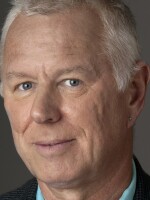
Christopher Joyce
Christopher Joyce is a correspondent on the science desk at NPR. His stories can be heard on all of NPR's news programs, including NPR's Morning Edition, All Things Considered, and Weekend Edition.
Joyce seeks out stories in some of the world's most inaccessible places. He has reported from remote villages in the Amazon and Central American rainforests, Tibetan outposts in the mountains of western China, and the bottom of an abandoned copper mine in Michigan's Upper Peninsula. Over the course of his career, Joyce has written stories about volcanoes, hurricanes, human evolution, tagging giant blue-fin tuna, climate change, wars in Kosovo and Iraq, and the artificial insemination of an African elephant.
For several years, Joyce was an editor and correspondent for NPR's Radio Expeditions, a documentary program on natural history and disappearing cultures produced in collaboration with the National Geographic Society that was heard frequently on Morning Edition.
Joyce came to NPR in 1993 as a part-time editor while finishing a book about tropical rainforests and, as he says, "I just fell in love with radio." For two years, Joyce worked on NPR's national desk and was responsible for NPR's Western coverage. But his interest in science and technology soon launched him into parallel work on NPR's science desk.
In addition, Joyce has written two non-fiction books on scientific topics for the popular market: Witnesses from the Grave: The Stories Bones Tell (with co-author Eric Stover); and Earthly Goods: Medicine-Hunting in the Rainforest.
Before coming to NPR, Joyce worked for ten years as the U.S. correspondent and editor for the British weekly magazine New Scientist.
Joyce's stories on forensic investigations into the massacres in Kosovo and Bosnia were part of NPR's war coverage that won a 1999 Overseas Press Club award. He was part of the Radio Expeditions reporting and editing team that won the 2001 Alfred I. duPont-Columbia University journalism award and the 2001 Sigma Delta Chi award from the Society of Professional Journalists. Joyce won the 2001 American Association for the Advancement of Science excellence in journalism award as well as the 2016 Communication Award from the National Academies of Sciences.
-
Sound gets into our brains and processed so quickly that it shapes all other perceptions, says neuroscientist Seth Horowitz. "You hear anywhere from 20 to 100 times faster than you see."
-
Christopher Clark, an engineer turned whale biologist, wired the world's oceans with hydrophones. Whales sing as they migrate, he learned. And the ship sounds clouding the ocean can deeply interfere.
-
Male humpback whales create "songs" together, scientists say. Katy Payne was the first to hear the shifts in pitch and pattern in the collective calls as complex music — haunting, evolving tunes.
-
The stethoscope seems so simple — a 19th century tool for listening more closely to the human heart or lungs. It also sparked a culture of listening that is transforming the way scientists learn.
-
Scientists say remains of four men exhumed from what was once an Anglican church suggest they were well-nourished, "high-status" leaders in the early 17th century colony. And one was likely Catholic.
-
Scientists assume a wave of people from what's now Siberia crossed into North America via Alaska, maybe 23,000 years ago. Genetics support that, but may also suggest another wave from Australasia.
-
The new evidence suggests the ancient skeleton is closely related to members of a Washington state tribe. The findings are likely to rekindle an old debate between scientists and Native Americans.
-
The rate at which the ice is shrinking at the ocean's edge in the West Antarctic has increased by 70 percent over the past decade, an analysis of satellite measurements suggests.
-
The 2.8 million-year-old bone may mark the first human branch in the primate family tree. It wasn't just a bigger brain that marked the shift, scientists say. It was also big changes in the mouth.
-
An expedition to the Pacific's Mariana Trench has found evidence that life exists miles below the surface. But it's not life as we know it.







